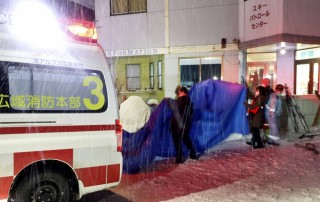Loading
Search
▼ Two Missing Skiers Presumed Dead After Nagano Avalanche
- Category:Other
Two men were confirmed to have died in a backcountry accident near a ski resort in Nagano Prefecture, police said Monday, a day after the pair were caught in an avalanche.
Authorities said they were unable to immediately confirm the nationalities of the men, who are believed to be foreign citizens.
But U.S. ski magazine Mountain Gazette reported that one of the dead was professional skier Kyle Smaine, a native of South Lake Tahoe, California.
Grant Gunderson, a photographer who was on the same ski trip as Smaine, wrote in an Instagram post Monday that the accident was an “absolute worst nightmare scenario,” saying that Smaine had been “thrown 50 meters by the air blast and buried and killed.”
Gunderson said the other unidentified man skiing with Smaine had been buried next to him and died of “internal injuries.”
Bad weather had prevented a search for the missing men Sunday.
Thirteen people in three groups consisting of foreign nationals were backcountry skiing and snowboarding on Sunday when five were caught in the avalanche near the Tsugaike Mountain Resort in the village of Otari, Nagano Prefecture. Three managed to escape down the mountain, with one sustaining a dislocated right shoulder.
The nationalities of the other people have also yet to be disclosed, but local media said they included Australians, Americans and Canadians.
The Otari Village Tourism Association said the accident had no connection with the ski resort, and that the people had been in an open mountainous area of the Tengu plateau of the nearly 2,500-meter Mount Hakuba Norikura, outside the resort’s grounds.
An avalanche warning and snow warning from the Meteorological Agency was and continued to be in place for the area as of Monday afternoon after a cold front brought heavy snow to a broad swath of Japan, including Nagano, last week.
The prefecture — which hosted the 1998 Winter Olympics — has been a popular destination for foreign tourists, especially those interested in skiing and snowboarding in the backcountry, or outside the boundaries of patrolled areas. The area’s high-quality powder snow, known among Japan aficionados as “Japow,” is one of its biggest draws.
While some Japanese ski resorts allow visitors to go off-trail at their own risk, experts say backcountry skiing and snowboarding requires specific skills, equipment and safety knowledge.
“The risks in the backcountry are real and should not be taken lightly — some of the dangers include avalanches and tree wells,” the Japan National Tourism Agency website says, adding that newcomers should join a backcountry ski tour with experienced guides.
Authorities said they were unable to immediately confirm the nationalities of the men, who are believed to be foreign citizens.
But U.S. ski magazine Mountain Gazette reported that one of the dead was professional skier Kyle Smaine, a native of South Lake Tahoe, California.
Grant Gunderson, a photographer who was on the same ski trip as Smaine, wrote in an Instagram post Monday that the accident was an “absolute worst nightmare scenario,” saying that Smaine had been “thrown 50 meters by the air blast and buried and killed.”
Gunderson said the other unidentified man skiing with Smaine had been buried next to him and died of “internal injuries.”
Bad weather had prevented a search for the missing men Sunday.
Thirteen people in three groups consisting of foreign nationals were backcountry skiing and snowboarding on Sunday when five were caught in the avalanche near the Tsugaike Mountain Resort in the village of Otari, Nagano Prefecture. Three managed to escape down the mountain, with one sustaining a dislocated right shoulder.
The nationalities of the other people have also yet to be disclosed, but local media said they included Australians, Americans and Canadians.
The Otari Village Tourism Association said the accident had no connection with the ski resort, and that the people had been in an open mountainous area of the Tengu plateau of the nearly 2,500-meter Mount Hakuba Norikura, outside the resort’s grounds.
An avalanche warning and snow warning from the Meteorological Agency was and continued to be in place for the area as of Monday afternoon after a cold front brought heavy snow to a broad swath of Japan, including Nagano, last week.
The prefecture — which hosted the 1998 Winter Olympics — has been a popular destination for foreign tourists, especially those interested in skiing and snowboarding in the backcountry, or outside the boundaries of patrolled areas. The area’s high-quality powder snow, known among Japan aficionados as “Japow,” is one of its biggest draws.
While some Japanese ski resorts allow visitors to go off-trail at their own risk, experts say backcountry skiing and snowboarding requires specific skills, equipment and safety knowledge.
“The risks in the backcountry are real and should not be taken lightly — some of the dangers include avalanches and tree wells,” the Japan National Tourism Agency website says, adding that newcomers should join a backcountry ski tour with experienced guides.
- January 30, 2023
- Comment (0)
- Trackback(0)


